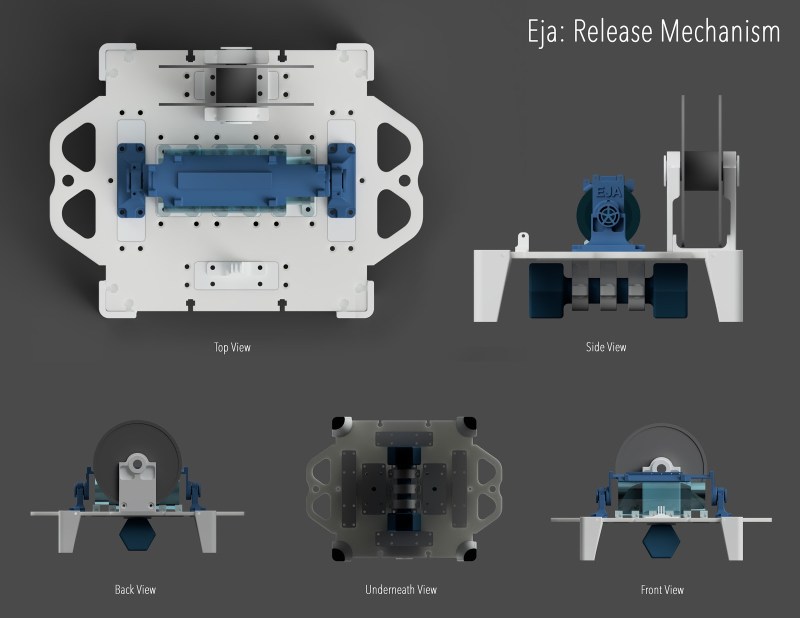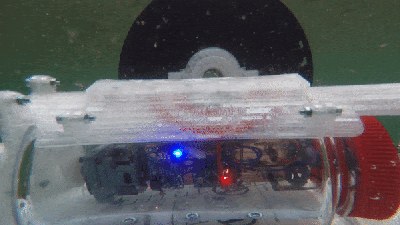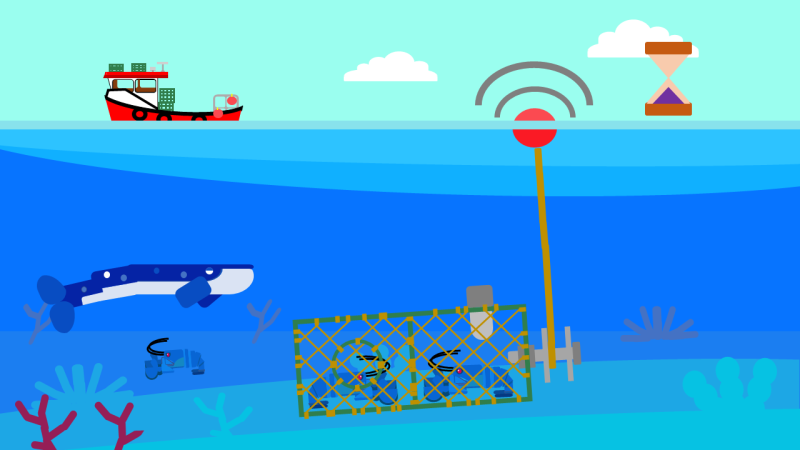There’s a laundry list of ways that humans are polluting the earth, and even though it might not look like it from the surface, the oceans seem to bear the brunt of our waste. Some research suggests that plastic doesn’t fully degrade as it ages, but instead breaks down into smaller and smaller bits that will be somewhere the in environment for such a long time it could be characterized in layman’s terms as forever.
Not only does waste of all kinds make its way to the oceans by rivers or simply by outright dumping, but commercial fishing gear is estimated to comprise around 10% of the waste in the great blue seas, and one of the four nonprofits help guide this year’s Hackaday Prize is looking to eliminate some of that waste and ensure it doesn’t cause other problems for marine life. This was the challenge for the Conservation X Labs dream team, three people who were each awarded a $6,000 micro-grant to work full time for two months on the problem.
It isn’t about simply collecting waste in the ocean, but rather about limiting the time that potentially harmful but necessary fishing equipment is in the water in the first place. For this two-month challenge, this team focused on long lines used by professional fishing operations to attach buoys to gear like lobster pots or crab traps. These ropes are a danger to large ocean animals such as whales when they get tangled in them and, if the lines detach from the traps, the traps themselves continue to trap and kill marine life for as long as they are lost underwater. This “ghost gear” is harmful in many different ways, and reducing its time in the water or “soak time” was the goal for the project.
Let’s take a closer look at their work after the break, and we can also see the video report they filed as the project wrapped up.
Preventing Ghost Gear From Haunting the Seas

The first solution to this issue is a method by which fishermen can accurately locate their equipment. The team designed a ropeless trap marking system that attaches to a trap underwater, which would eliminate the need for a permanent fixed rope attached to a traditional buoy. The design includes a smart buoy that stays attached to the trap until its ready to be released, and then at the right moment, presumably when the trap is full, the buoy is released and is able to float up to the surface. While not truly “ropeless” since the buoy spools out a line as it makes its way to the surface, it does dramatically reduce the amount of time that the rope is actively dangling in the water where any passing animal can get snagged on it, and therefore also reduces the chances that the trap is lost as a result of a broken line.
The current prototype for the smart buoy is housed in a Nalgene bottle, which is made out of strong plastic capable of withstanding pressures to around 160 meters of depth. Inside the bottle is a set of electronics that make locating the buoy much easier. Each version contains a GPS module, a LoRa radio module, and an ESP32 to tie it all together, plus a battery and charging circuitry. One of the prototype boards additionally contains a cellular modem for additional tracking abilities.
Retrieving the Equipment in One Piece
Of course the buoy is not going to be able to communicate with much of anything while it’s sleeping with the fishes, so it also houses a set of magnetic wipers within its protective Nalgene case that keep it secured to the submerged trap. When it senses that it is time to deploy, a small motor moves the magnets which release it from its external housing mechanism. From there it can simply float to the surface while it deploys a small rope from a spool that’s also housed on the device. The device can communicate easily with its various included hardware to an on-boat gateway or to a properly-equipped cell phone.

Currently the prototype smart buoy deploys itself after a set amount of time has elapsed; in the video demonstration it is set to deploy every two minutes so that it can be tested quickly. In a real-world scenario though it could keep the timer feature and simply deploy at the end of the day, but the amount of electronics in the buoy allows for a number of other options for deploying itself that the team hopes to expand upon in the future. Other planned upgrades include using LEDs in the buoy to aid in location, and using cameras in the bottle to make determinations about the state of the trap. Some cameras were used in testing in Lake Ontario and the results showed that this will likely be a difficult problem to solve.
Development Requires Cooperation
Perhaps the most important part of this project isn’t technology-based at all, but focuses on ensuring adoption of this technology by fishermen. These intelligent buoys have to be cost effective and simple to use. Since ghost gear costs them money as well, in terms of lost equipment, lost catch, and the long-term damage to the environment that is caused as a result, the team plans to work closely with the fishermen to make sure that all of their concerns about the equipment are addressed and their needs are met, both from a technology point-of-view but also from one of usability and economics.
There are certainly more questions to answer and more problems to solve, but this project has a promising start and will certainly help the declining situations in the oceans when it can be fully developed and implemented. We look forward to seeing Conservation X Labs’ future designs and solutions.



















Marine microbes digest plastic. https://www.nature.com/news/2011/110328/full/news.2011.191.html
Biodegradation of mixture of plastic films by tailored marine consortia. https://www.sciencedirect.com/science/article/pii/S0304389419305060
The above are both a problem and a solution, your plastic garbage may not last as long as you think in the ocean, but neither will your equipment that you deployed there!
Sound great, but some people in charge don’t want a solution.
When there is a problem, they make money from it.
“commercial fishing gear is estimated to comprise around 10%” lets apply the idea of recognizing an impossibility. China and the greater Asian region produce about 10 million metric tones of plastic waste a year that reaches the oceans. So this claim says there are a million tones of fishing gear lost a year. That is a lot. Not quite unbelievable, but a lot. If fishing gear has a greater half-life in the ocean, which seems likely with heavier thicker stuff and UV resistance, etc. One hawser used with trawling nets could easily weight a ton or more. They would have to loose the equivalent of 500,000 of those or a million.
I suppose one could find the total mass of new gear manufactured each year and subtract the amount of old gear piled on shore (common), burned (not so common), etc. The 10% just doesn’t pass the smell test. I suspect the fishing gear is easier to identify and count. I’m also sure the vast majority of commercial fishing boats will just cut damaged gear loose rather than deal with it onboard.
Apparently there’s 177 million tons of fish a year caught (Seems like reducing that number should be the first step, since it’s probably mostly not even healthy with all the mercury).
It seems like the number might not be too far off. 1 ton of plastic waste per 177 tons of fish doesn’t sound too hard to believe, if everyone just dumped nets all the time.
Seems hard to believe if people are actually being careful, but otherwise it might be possible.
It is healthier than not getting protein. 177 to one seems way too low to me. The net bag on a trawler must have way more than that ratio in each tow. One fish on a section of long-line must be a hundred times more than the mass of the line. The individual fisherman in “third world” situations is much less efficient but I doubt they can afford those kinds of loses.
Maybe it is more about the half-life of fishing gear and a find-ability bias compared to other sources of plastics.
Why not just have the buoy attached to a reel that is locked with a dissolveable time pin? When deployed the buoy is captive but after a certain time the pin is dissolved by the sea water and the buoy deploys. Since I assume lobstermen check traps on a schedule they just have to put in differently timed time pins in the trap and when they return to the GSP coordinates where they dropped the trap the buoy will be there, but not before so only lobstermen have to deal with the traps and not whales. And this is much simpler than the above solution.
+1 for a solution that doesn’t require electronics and is much harder to fail.
Or at least use a dissolveable pin as a failsafe, so if the electronics fail, then the float is eventually released by the pin.
More or less already done;
Resqunit – https://youtu.be/B8fGA6yWCb8
What’s the risk weighting of whales & ropes vs crustaceans & ghost traps? I have no data to support but it seems like it would be the latter. Is there no simple way to make a rope more identifiable to a whale?
At a minimum, the electronic buoy could be used for fisheries management / enforcement. Licensed traps must use e-buoys. If you don’t have an e-buoy, your gear gets removed and scrapped. The dissolveable pin idea is great as well.
$6000 for two months work? Go fish…
Industrial scale fishing is not necessary. We just stop fishing. Problem solved.
Fishing provides the income to around 500 million people, so you’re saying just put the equivalent of Europe out of jobs, not to mention the food it provides.
And you can be one of the millions who stop eating when there’s not enough food.
2100 hackaday prize: the ocean is littered with ghost electronics, toxic solder that was never really to EU specs, and toxic and leaking lithium batteries. Find a way to recover them!
Whilst I appreciate the goal here, and the effort, This solution seems to replace one problem with another.
Surely hemp ropes would be a better and far simpler solution?
For smoking? Sure. Cotton and hemp gear lasts one season unless it is coated with tar. Fishing towns always had a tar pit or tar flat for coating nets and ropes with tar/creosote.
You can throw a synthetic net and gear in a pile with dead fish in it and it is OK a year later. Natural fiber gear will be destroyed. We need hybrid plants, like an ear of corn that has a trout inside.
Ah, interesting. I’ve natural ropes which have lasted much longer, but they’re not dumped in the sea or with dead fish; I can imagine that does take a toll.
>Some research suggests that plastic doesn’t fully degrade as it ages, but instead breaks down into smaller and smaller bits
Which plastic?
Plastic degrades biologically by organisms eating the polymer chains at the ends. As a solid piece, it is hard to break down in this way, because the digestive enzymes can’t find the ends of the polymer chains at the surface. When it breaks down to smaller pieces, it becomes more and more accessible to micro-organisms and it breaks down faster.
As an ageing diver who has rescued or disabled many pots over the years, I feel the need to point out a few weaknesses of the device methodolgy for Lobster/Crab pots. Generally the buoy normally used for these are little danger to wildlife whilst being a hazard for unwary sailors/boaters. The gear is more often lost because the pots or their lines getting snagged on the bottom. Either on the reef or wreck. WInching the jammed pot results in a broken buoy line. That’s a line that is far stronger than the one used on the deploy reel above. The solution to my mind is simple and that is legislation to make the use of pots conditional of having part or all of the net fixing degradable so that a panel will fall out and release any catch, rather than it remaining till it dies and become bait for the next lobster or crab.
That’s nice and all, but how do you intend to retrieve a 1000lb crab pot containing 500lb of crab with that line?
I think the solution misses the mark. A better idea is a pot attached to air bags that can be filled with CO2 to return it to the surface when full. Even better than that is a pot that can communicate with nearby surface vessels to provide status and respond to a command to surface. The JANUS acoustic protocol looks like it would be ideal for this application. A crabbing vessel would be able to determine the entire string status before pulling a single pot. There’s some technologies that would need engineering to be reliable within what can only be described as a hostile environment. You’d need the airbag system to be robust enough to survive being deployed multiple times within a season, possibly involving redundancy with enough bags to survive losing one without losing the pot. You’d also need the CO2 refill system to be easy to operate reliably in subzero temperatures and rolling seas by a guy wearing thick gloves. Also, how do you full a pot is? JANUS doesn’t have the bandwidth for imagery, so that determination will need to be made without human interpretation.
Dreamers team actually. There is only one solution to all this pollution and we all know what it is.
I would consider starting out small, use pinkish traps to catch bait, the problem is that these traps are constantly stolen by other fisherman. I believe charter guys would gladly pay a little more for trap equipped with this, because the odds of it getting stolen are much less. Also we have a problem with our traps during storms. Having float on a rope tends to just help them move in strong winds and waves. Would love to try something like this out. Having a bouy that could be activated by a cell phone app would be a game changer